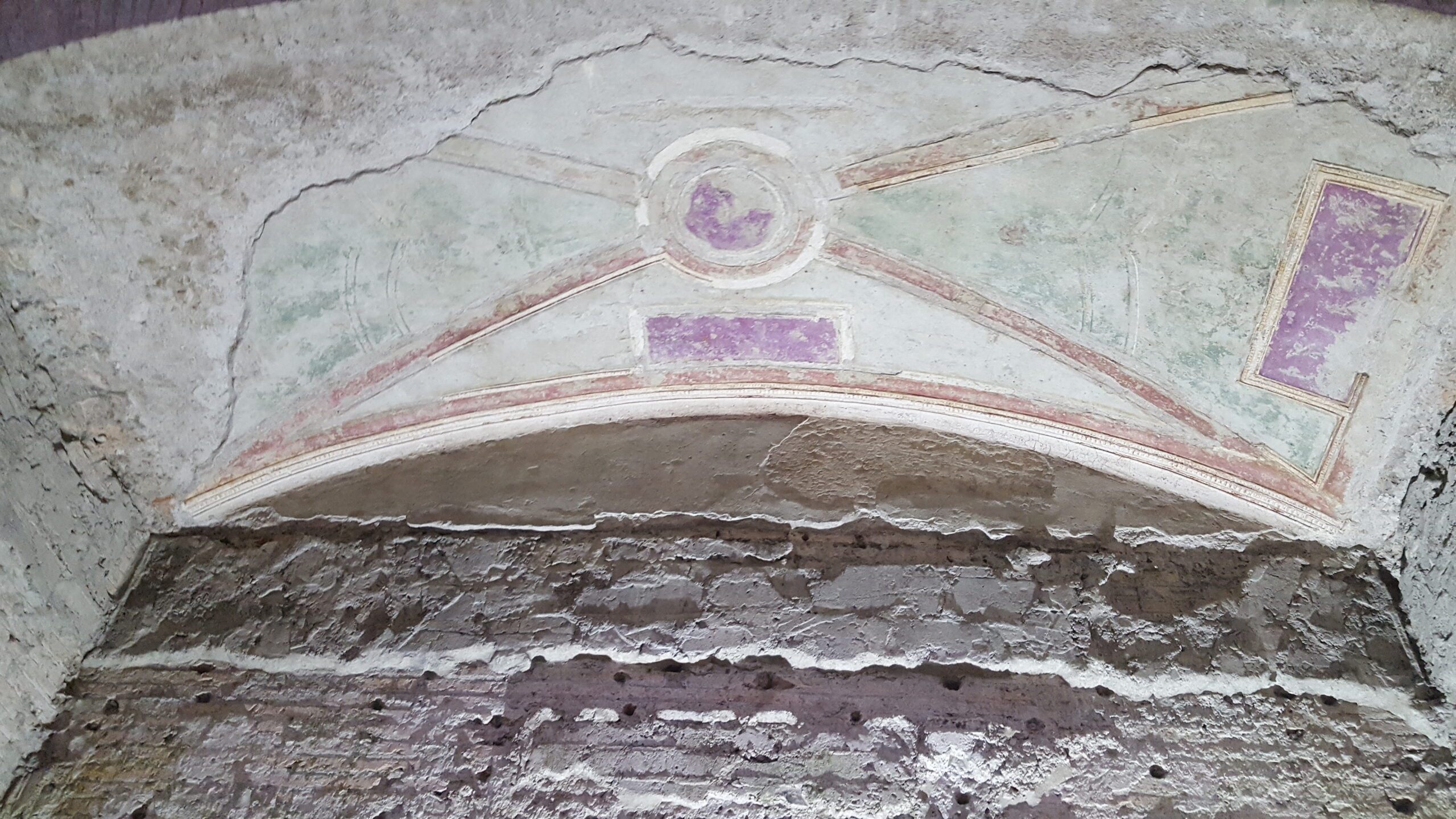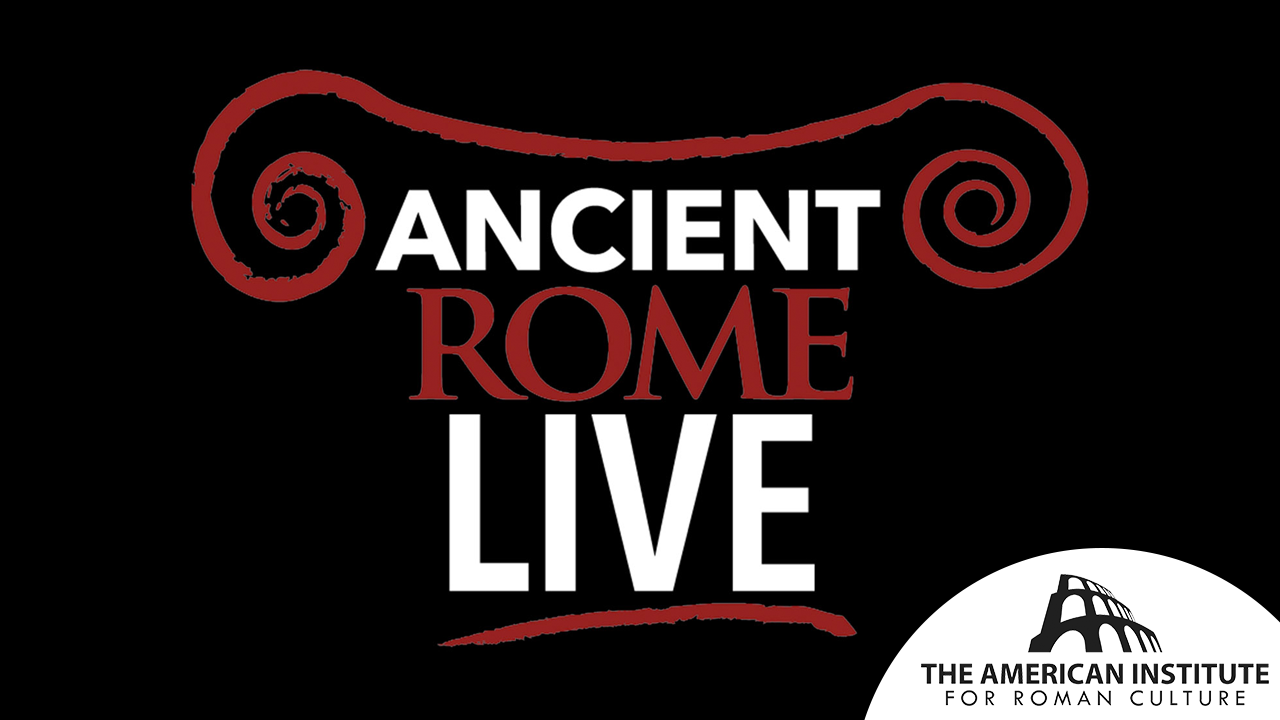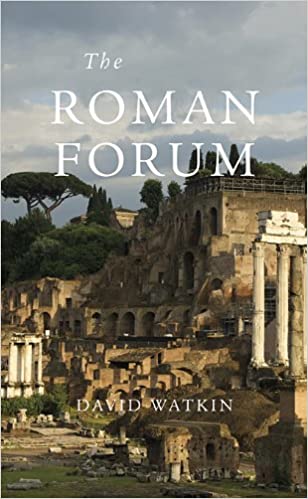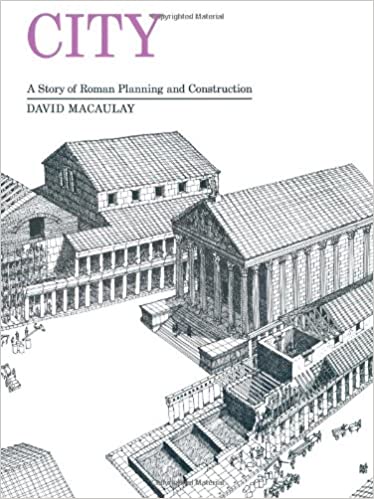The Domus Aurea, or golden palace, was the enormous complex commissioned by Nero between 64 and 66 CE which stretches across the Esquiline hill. It was constructed following the most devastating fire Rome had ever known, which raged through parts of the city for six days and significantly damaged buildings across the city. The Domus Transitoria, Nero’s former palace, was among the ruins. Rumors were spread that Nero himself had started the fire to create more space for his newer and larger palace complex. Academics continue to debate whether the fire was an accident or was actually started on Nero’s orders, though regardless of intention, it clearly provided an opportunity to build a new complex, including the Domus Aurea and gardens. It was used as Nero’s residence and consisted of two wings and a central corridor. The eastern wing was used to receive guests, while the western wing was for Nero’s private use. Today only small portions of the palace have survived.
The octagonal room with an oculus in the ceiling, whose design resembles that of the Pantheon, is one of the complex’s most remarkable rooms. The palace was embellished with a variety of colored marble slabs and frescoes of grotesques. Grotesques are designs of arabesques, garlands, and highly detailed fantastical human and animal figures which were named after the Italian word grotta, meaning cave. When Domus Aurea’s ruins were rediscovered in the 14th century CE, they were completely buried in dirt and debris and were thought to be painted caves. The rediscovered style had a significant impact on Renaissance art. One significant example is that of Raffaello Sanzio, one of the most influential artists of the era, who is known to have incorporated the style into the painted decoration of the chambers of the Apostolic Palace in the Vatican.
Nero gained a reputation as one of the most unpopular Roman emperors the city had ever known. After his death in 68 CE, every trace of the former emperor was eliminated in the process of damnatio memoriae. The construction of the palace was discontinued and in 104 CE, the Baths of Trajan were constructed atop its remains. Supporting walls were built straight through the Domus Aurea to support the new baths which can still be seen today. The Colosseum was constructed to replace the artificial lake that once adorned the gardens in an effort to return the space to the public property of the citizens of Rome.
SOURCES
- Gray-Fow, M. J. G. (1998). Why the Christians ? Nero and the Great Fire. Latomus, 57(3), 595–616. http://www.jstor.org/stable/41538370
- Gurgone, F., & Ansaloni, M. (2015). Golden House of an Emperor. Archaeology, 68(5), 37–43. http://www.jstor.org/stable/43825196
- Hannah, R., Magli, G., & Palmieri, A. (2016). Nero’s “Solar” Kingship and the Architecture of the Domus Aurea. Numen, 63(5/6), 511–524. http://www.jstor.org/stable/44505307
- La Regina, A., Guida archeologica di Roma, Mondadori Electa: Milan, 2018.
Read more:
Vestibulum eius fuit, in quo colossus CXX pedum staret ipsius effigie; tanta laxitas, ut porticus triplices miliarias haberet; item stagnum maris instar, circumsaeptum aedificiis ad urbium speciem; rura insuper, arvis atque vinetis et pascuis silvisque varia, cum multitudine omnis generis pecudum ac ferarum. In ceteris partibus cuncta auro lita, distincta gemmis unionumque [large pearl oysters, cf. conchis erant; cenationes laqueatae tabulis eburneis versatilibus, ut flores, fistulatis, ut unguenta desuper spargerentur; praecipua cenationum rotunda, quae perpetuo diebus ac noctibus vice mundi circumageretur; balineae marinis et albulis fluentes aquis. eius modi domum cum absolutam dedicaret, hactenus comprobavit, ut se diceret quasi p167 hominem tandem habitare coepisse. The landscape gardening of the great park in which the buildings were set is also emphasised by Tacitus: in qua haud perinde gemmae et aurum miraculo essent . . . quam arva et stagna et in modum solitudinum hinc silvae, inde aperta spatia et prospectus, magistris et machinatoribus Severo et Celere). Cf. Seneca, Ep. XIV.2.15.
The area occupied is further defined by Martial (de spect. 2), who is writing in praise of Vespasian:
| Hic ubi sidereus propius videt astra colossus |
(See Colossus Neronis; sidereus simply means ‘glittering.’)
| et crescunt media pegmata celsa via, |
(perhaps the scaffolding for the erection of the arch of Titus: the usual explanation of the line — HJ 17 — to mean that the machinery of the amphitheatre was stored in the ruins of the vestibule of the Golden House is unsatisfactory — why media via? The blocking up of the Sacra Via by Nero must have been intensely unpopular and it seems strange to store or construct ‘pegmata’ there.)
invidiosa feri radiabant atria regis
(the atrium stood on the summit of the Velia)
| unaque iam tota stabat in urbe domus. |
[This is an echo of the epigram quoted by Suetonius, Nero,39:
|
Roma domus fiet: Veios migrate, Quirites, si non et Veios occupat ista domus; |
|
Hic ubi conspicui venerabilis amphitheatri erigitur moles, stagna Neronis erant. Hic ubi miramur velocia munera thermas, [Titianas, q.v.] abstulerat miseris tecta superbus ager. Claudia diffusas ubi porticus explicit umbras, ultima pars aulae deficientis erat |
(i.e. the domus Aurea extended no further over the Caelian than the site of the temple of Claudius (q.v.), which was begun by Agrippina, destroyed by Nero, and built anew by Vespasian). That it did not extend beyond the Subura on the north is clear from the fact that the temple of Tellus portico Livia continued to exist; while on the east the horti Macenatis, already the property of the imperial house, formed its natural boundary.
According to Hülsen’s estimate the area thus included amounted to •about 125 acres, while that of the Vatican, including the garden and S. Peter’s with its piazza, is •about 75 acres. Rivoira, however, puts p168 the area at •370 acres, that of Hyde Parkº being 390. It would be still further increased if we add to it the area of the long lines of lofty arcades on either side of the Sacra via, which Nero transformed into a monumental avenue of approach to the vestibule of his palace. Mem. Am. Acad. V.115‑126; see also HFP 49; the northern arcade began just east of the basilica Aemilia It was interrupted by the road leading east of the temple of the Penates, which passed by an archway (the so‑called arcus Latronis arcus Latronis under the north-west corner of the basilica of Constantine. The northern end of the portico behind it has been obliterated by the construction of the basilica. On the south the arcade began at the Regia, and ran eastward up to the beginning of the Cilvus Palantinus (q.v.), which thenceforward diverged from the Sacra via at right angles opposite the centre of the vestibule of the domus Aurea. It followed the clivus some way beyond the end of the Nova via, as far as the Arcus Domitiani (q.v.) On the south the portico behind the arcade extended as far as the Nova via, on each side of which an arcade also ran. The remains of these very extensive arcades and porticoes are comparatively scanty, except for their massive foundation walls (see Porticus Margaritaria). Most of the travertine blocks of the pillars have been pilfered by searchers for building material (especially in the time of Alexander VII,º according to LR 211), and very often nothing is left but their impressions in the concrete of the later brickfaced walls, which were built between them when the porticoes were used as horrea. The blocks hitherto attributed to the arch of Fabii (NS 1882, 222‑225) have turned out to belong to the arcades.
The entrance to the vestibule of the domus Aurea was, no doubt, opposite to the Sacra via — approximately in the position of the façade of the church of S. Francesca Romana. It must have had a great portico or peristyle (for it is also called atrium), in the centre of which stood the Colossus (q.v.) a statue of Nero •120 feet high. It is unnecessary to suppose, however, as Weege does, that the Porticus Triplices Miliarie (q.v.) are to be sought here. Porticoes, a walk several times along which (or we may even say, round the whole of which) provided a promenade of a measured mile, were in great vogue among the Romans (see Porticus Miliarensis and Porticus Triumphi.
The construction of the vestibule forced the Sacra Via (q.v.) to cross the Velia somewhat further south than it had done hitherto (though the pavement of the Augustan Sacra via has been found under the steps of the temple of Venus and Rome, we have no knowledge of the buildings which occupied the site of the vestibule), and this road must p169 have been closed for ordinary traffic after 64 A.D. We may notice that the route of Nero’s triumph in 68 A.D. did not include it; and the arch of Titus was erected at the only possible point on the Velia. That the vestibule lay in ruins until the construction of the temple of Venus and Rome by Hadrian (HJ 17) seems unlikely, for we know that the Colossus stood in its original position until he moved it.
Beyond the vestibule a view opened out over the great park described above, and down on the lake, on the site of which the Colosseum was built, which formed the centre of the whole: and in the park around it, besides the main palace on the north-east, were various smaller detached buildings, as at Hadrian’s Villa.
On the Velia itself, to the north of the temple of Venus and Rome and to the east of the basilica of Constantine, are remains of buildings now covered by a garden, in which architects of the sixteenth century (Fra Giocondo? and Ligorio) saw two oblong courts surrounded by porticoes (Mél. 1891, 161‑167; Archaeologia LI.2 (1888) 498; Mitt. 1892, 289, 291; JRS 1919, 180). To the east a small nymphaeum, adorned with niches for statues and decorated with sea-shells, was found in 1895 (NS 1895, 79; BC 1895, 127; LR 361, 362, who says that it was in the same Vigna dei Nobili that the excavations of 1668 were made, in which an interesting painting, perhaps representing the harbour of Puteoli, was found; cf. HJ 322; PBS VII.57, No. 2. That this painting cannot be earlier than the middle of the second century A.D. is clear from the occurrence in it of the name Balineum Faustines). On the Palatine we must attribute to it the irregular curving concrete foundations which cut through the remains of the Domus Transitoria (q.v.) under the triclinium of the Flavian palace. Remains of the buildings round the stagnum were found on the north of the Colosseum (NS 1897, 59; BC 1897, 165), and foundations of others were recognised in cutting the drain from S. Clemente to the Colosseum3 (see Castra Misenatium).
But the main palace was situated further to the east, on the mons Oppius, above the via Labicana, to the south of the porticus Liviae. It faced almost due south, and occupied a rectangular area of •about 400 by 200 yards. The plan is not one which is familiar in Rome. The central portion is built in the shape of a P, the two sides being inclined to one another so as to enclose a trapezoidal court. The façades were decorated with colonnades; and in the centre a large rectangular room (No. 60 in the plans) rose higher, special emphasis being laid upon it — as in some of the Roman villas represented in the landscapes painted in Pompeian houses (cf. esp. Mitt. 1911, 73 sqq., pl. VIII.1). Villas with a similar plan have been found at Val Catena, on the island of Brioni, near Pola (OJ 1907, Beibl. p170 46; 1915, Beibl. 133; Swoboda, Römische und Romanische Paläste, 51 sqq.).
The wings are disproportionately large. Behind the façade of the west wing is a row of long and comparatively narrow rooms, each divided into two parts by niches, so as to serve as triclinia either in summer or in winter. At the back they opened on a garden with a fountain in the centre; and behind it again is a long, lofty cryptoporticus, at the beginning of which traces of mosaic pavements, belonging to earlier houses on the site, may be seen. The east wing is quite different in arrangement, and not all the rooms have yet been cleared (an up-to‑date plan of the whole will be found in ZA 136, 137). In one of them (76) we see the earliest existing example of a groined cross vault; while another (84) is interesting as being octagonal in plan, with a circular dome having an opening in the centre. This room appears never to have been completed.
The remains of this palace, which were damaged by fire in 104 A.D., were covered over and filled up by Trajan (Ill. 16, in which the brick-work in the middle belongs to Nero, the finer brickwork with opus reticulatum, on the right, having been added by Trajan). The rough brickwork on the left is pre-Trajanic, but of uncertain age), who erected his huge thermae over them; and they have therefore come down to us in a very fair state of preservation, especially as regards the paintings, though those of the west wing, which has been more completely opened up, have perished since their discovery in 1811; whereas those of the east wing, though known far earlier, have been far less exposed to the air. The ruins indeed have been known since the early Renaissance, and were visited by many of the artists of the time, and by their successors right onwards till the early nineteenth century. Many of their signatures are actually preserved, including that of Giovanni da Udine, the assistant of Raphael in the Loggia of the Vatican and elsewhere (Jahrb. d. Inst. 1913, 140‑158). The paintings are all of them on a small scale (Ill. 21), with little figures painted or in stucco relief, often with stucco framing, and they must always have been difficult to see in the lofty rooms of the Golden House, to which, though well enough suited for •’columbaria,’ this style of decoration seems to us singularly ill adapted; while the execution, except in a few rooms (that in the centre of the whole building with the ceiling known as the ‘Volta Dorata’ (Ill. 22), and that in which the Laocoon was found — Nos. 60, 80 on the plans), is decidedly inferior to what we should expect from what Pliny tells us of the artist who was responsible for them, though no doubt, like Raphael, he had numerous assistants: fuit et nuper gravis ac severus idemque floridissimus pictor Famulus (so the MSS.; the editors prefer Amulius or Fabullus; for the name cf. D. Haterius Famulus (CILIII.7167; RhM 1927, 326). See also RE VI.1985.) . . . paucis diei horis pingebat, id quoque cum gravitate, quod semper p171 togatus, quamquam in machinis. carcer eius artis domus aurea fuit, et ideo non extant exempla alia magnopere).
For reproductions and a careful study of the numerous drawings and engravings of these paintings, see Weege in Jahrb. d. Inst. 1913, 127‑244, and Ant. Denk. III.14‑18; cf. also BC 1895, 174‑181; cf. PBS VII.14 sqq. (where the legend Palazzo di Tito is very often incorrect); VIII.35‑51; Mitt. 1911, 145‑147; 1927, 66; Mem. Am. Acad. IV.39, 40.
The great reservoir known as the Sette Sale, which really consists of nine great chambers side by side, also belonged originally to the Golden House, as its construction and orientation show, though it was later made to serve Trajan’s thermae. Apparently rooms were built on top of it (‘these vaults had buildings over them, for we found at the top of them mosaick pavement,’ Pococke, BM Add. MSS. 22980, f.15v, 16v writing about 1730).
As to the internal decoration, we are told that Nero collected hundreds of works of art from all over the world for the adornment of the palace, who, after describing about 365 Greek statues, says that the best of them had been used for this purpose). For the rest, the coloured marbles were in great part removed by Trajan; and the gems and pearls mentioned by Suetonius seem to have shared their fate. Nor have the dining-rooms as yet come to light, which he describes, with their ceilings of ivory plaques, through which flowers could be scattered, or pierced with pipes for spraying perfumes — still less the circular one which continually revolved day and night. Nor have traces of either salt or sulphurous water been recognised in the channels and pipes. Either there is much more yet to be found, or his account is somewhat exaggerated. But the palace is sufficiently interesting as it is.
At the time of Nero’s death the Golden House was not completed (e.g. the cryptoporticus in the west wing had only its ceiling painted, the walls having been only roughly plastered, and the pavement not yet laid), and Otho at once assigned a large sum (50,000,000 sesterces, or £500,000 for its completion (Suet. Otho 7). Vitellius and his wife are said to have ridiculed it as mean and lacking in comfort, but this may have been only gossip.
Vespasian and his successors, who knew how unpopular its construction had been, vied with one another in restoring its site to public uses. in illa invisa et spoliis civium exstructa domo, and the last two lines of Martial’s epigram after its destruction, the rest of which we have already quoted:
|
Reddita Roma sibi est et sunt te praeside, Caesar, deliciae populi, quae fuerant domini. |
He himself began by draining the lake in the centre of the park and erecting the Colosseum on its site, thereby restoring the streets of the p172 whole quarter to public uses once more. The works of art which Nero had collected in the Golden House were dedicated by Vespasian in the temple of Peace and other buildings erected by him ex omnibus quae rettuli clarissima quaeque iam sunt dicata a Vespasiano principe in templo Pacis aliisque eius operibus, violentia Neronis in urbem convecta et in sellariis domus aureae disposita).
His son Titus erected thermae (q.v.) opposite the Colosseum; but the main palace must have still remained in use during his reign; for Pliny saw there in 79 A.D. (the year in which Titus came to the throne and in which he himself died) the Laocoon, qui est in Titi imperatoris domo. As in almost the next sentence he speaks of the works of art in the Palatinae domus Caesarum, the Golden House must be meant; though there is some doubt whether the Laocoon was actually found in Room 80 in 1506 (Jahrb. d. Inst. 1913, 231‑239). There are also traces of alterations in some of the rooms at this period (ib. 161). On the Palatine the fire of 80 Hier. a. Abr. 2096; Stat. Silv. I.1.33) appears to have destroyed what the fire of Nero had spared, and Domitian was entirely occupied in rebuilding the imperial palaces. As we have seen it is unlikely that the vestibule had been destroyed as yet. Trajan had hardly completed Domitian’s work when a fire in 104 A.D. destroyed the Golden House (Hier. a. Abr. 2120: Romae aurea domus incendio conflagravit; cf. Orosius 7.12) and hastened his intention of constructing his huge thermae (q.v) on the site. A number of the openings of the domus Aurea were walled up with concrete faced with brickwork and opus reticulatum in order to give greater stability, and the rooms were filled with rubbish except for the construction of the oratory of S. Felicitas there in the sixth century A.D. Here was found a very interesting calendar (RE II. A. 1583).
The vestibule was finally destroyed by Hadrian in 121 A.D., and the temple of Rome erected on its site; and after that the Golden House has no history. The regio aurea of the Middle Ages has wrongly been fixed here (RL 1909, 224‑230) Owing to the erroneous identification of the Baths of Trajan with the Baths of Titus, the ruins were called Palazzo di Tito during the Renaissance and in the seventeenth century, though De Romanis, Piale and Fea knew the truth as early as the ‘twenties of last century. The history of the excavations is given by Weege (op. cit. 137‑140), who also provides a full bibliography of drawings, plans, engravings, etc. (ib. 151‑159). See also LR 361‑365; LS I.232; II.222‑228; III.169; IV.10; HJ 273‑279; CRA 1914, 231; NA 16th June, 1914, 655‑661; Hermes, 1914, 158‑160; YW 1920, 84; ZA 128‑144; RA 73‑78. For the graffiti found in the west wing see BC 1895, 195‑197.
This content is brought to you by The American Institute for Roman Culture, a 501(C)3 US Non-Profit Organization.
Please support our mission to aid learning and understanding of ancient Rome through free-to-access content by donating today.
Cite This Page
Cite this page as: Darius Arya, The American Institute for Roman Culture, “Domus Aurea” Ancient Rome Live. Last modified 04/24/2021. https://ancientromelive.org/domus-aurea/
License
Created by The American Institute of Roman Culture, published on 04/06/2021 under the following license: Creative Commons: Attribution-NonCommercial-ShareAlike. This license lets others remix, tweak, and build upon this content non-commercially, as long as they credit the author and license their new creations under the identical terms. Please note that content linked from this page may have different licensing terms.







